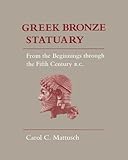Greek Bronze Statuary : From the Beginnings Through the Fifth Century B.C. / Carol C. Mattusch.
Material type: TextPublisher: Ithaca, NY : Cornell University Press, [2019]Copyright date: ©1988Description: 1 online resource (288 p.) : 165 b&w photographsContent type:
TextPublisher: Ithaca, NY : Cornell University Press, [2019]Copyright date: ©1988Description: 1 online resource (288 p.) : 165 b&w photographsContent type: - 9781501746062
- 733/.3
- online - DeGruyter
| Item type | Current library | Call number | URL | Status | Notes | Barcode | |
|---|---|---|---|---|---|---|---|
 eBook
eBook
|
Biblioteca "Angelicum" Pont. Univ. S.Tommaso d'Aquino Nuvola online | online - DeGruyter (Browse shelf(Opens below)) | Online access | Not for loan (Accesso limitato) | Accesso per gli utenti autorizzati / Access for authorized users | (dgr)9781501746062 |
Browsing Biblioteca "Angelicum" Pont. Univ. S.Tommaso d'Aquino shelves, Shelving location: Nuvola online Close shelf browser (Hides shelf browser)

|

|

|

|

|

|

|
||
| online - DeGruyter Literary Knowledge : Humanistic Inquiry and the Philosophy of Science / | online - DeGruyter Pienza : The Creation of a Renaissance City / | online - DeGruyter The Jesuit Mind : The Mentality of an Elite in Early Modern France / | online - DeGruyter Greek Bronze Statuary : From the Beginnings Through the Fifth Century B.C. / | online - DeGruyter Governing Capital : International Finance and Mexican Politics / | online - DeGruyter Modernity, Aesthetics, and the Bounds of Art / | online - DeGruyter Fictions, Philosophies, and the Problems of Poetics / |
Frontmatter -- CONTENTS -- PREFACE -- ABBREVIATIONS -- I. DISCOVERIES -- 2. CASTING -- 3. BEGINNINGS -- 4. DEVELOPMENTS -- 5. CHALLENGES -- 6. VARIATIONS -- 7. ELABORATION -- 8. POSSIBILITIES -- 9. THE HUMAN FIGURE AND ITS SCULPTORS -- APPENDIX. ANCIENT EVIDENCE OF THE LOST-WAX PROCESS -- INDEX
restricted access online access with authorization star
http://purl.org/coar/access_right/c_16ec
Freestanding bronze statuary was the primary mode of artistic expression in classical Greece, yet it was not until the nineteenth century that any original large statues of that period were unearthed. Although ancient literature has preserved information about the most famous Greek sculptors who worked in bronze, our perception of the art has been limited by the small number of extant originals from the sixth and fifth centuries B.C. there remain fewer than ten large cast bronze statues, a like number of bronze heads, an assortment of fragments, and some clay molds for casting.Carol Mattusch enriches our knowledge of this beloved but elusive art form in a comprehensive study of the style and techniques of bronze statuary during the Archaic (6th century B.C.) and Classical (5th century B.C.) periods.
Mode of access: Internet via World Wide Web.
In English.
Description based on online resource; title from PDF title page (publisher's Web site, viewed 02. Mrz 2022)


